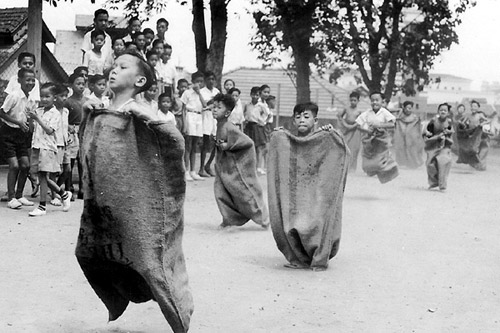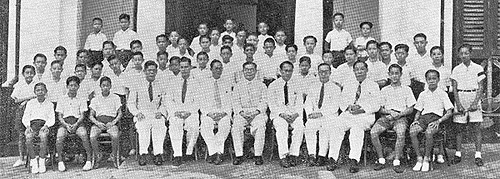Affectionately known as the Mr. Chips of ACS, Mr Earnest Lau has
influenced the lives of thousands of ACSian students. Many older
ACSians associate him with the stirring and nostalgic “40 Years On”
which he taught and sang with gusto when he first joined ACS as a
teacher in the mid-fifties, whilst others from the 1977 to 1983 era
remember his charismatic leadership when he was Principal.
An
author of several books, Mr Lau is presently the Archivist of The
Methodist Church in Singapore.
We
invited him to share his vast knowledge of ACS history with our
readers and in this issue, he reminisces his school days in ACS.
The Coleman Street Experience
I became a pupil of the Anglo-Chinese School in Coleman
Street in January 1938 when I was admitted to Standard II at age 9.
Prior to that, my brother and I had been largely home schooled by my
mother, who was Headmistress of the Geylang Methodist Girls’ School,
and where I was briefly introduced to formal education.
I vividly remember my teachers because their
character and strict teaching played an important role in
influencing me. In Standard IIA (equivalent to P4), our classmaster
was an elderly and saintly man, Mr S.M. Sundram, a model of
patience who never lost his temper although he did raise his
voice occasionally. He believed in incentives, and offered prize
money of 5, 10 or even the princely sum of 50 cents to the first
alert boy who could answer a question which he posed at odd moments.
Although we may now smile at the puny sums he offered when a bowl of
noodles cost 2 or 3 cents, eagerly snapped up by hungry schoolboys
at recess time in the tiffin shed. But the modest prizes were an
incentive for the boys to keep on their toes. He also introduced us
to Bible verses, the earliest of which I recall was John 1:4, “In
Him was Life, and the Life was the Light of men.” Of course, there
were other verses, as well as the famous verses inscribed all round
the upper walls of the Chapel Hall from Proverbs (3:5-6) and
Ecclesiastes (12:1), and which all true-blue ACS boys know by heart.
In Standard IVA, Miss Bella Russell taught
English, and her proper English pronunciation and use of the
language provided us with a valuable model, although the other
teachers also spoke clearly and well. Miss Russell also
taught singing in the Chapel hall which had been built by our
founder in 1885. She emphasised singing using ‘the head tone’, is
how she put it. We practised the ACS anthem and hymns (from “Hymns
of the Kingdom”, no longer used) for the weekly Chapel, as well as
English folk songs and ballads (such as “Barbara Allen” and “Loch
Lomond”) and ‘patriotic’ songs (such as “God Save the King” and
“Rule Britannia”) for special occasions like Empire Day and
Founder’s Day. Then there was an annual Children’s Concert held at
the Victoria Memorial Hall which we all attended with a number of
other city schools. Here we sang the songs we had learnt in singing
lessons, an experience enriched by magnificent pipe organ music
played by an expatriate official. All these seem distant to us
today, but they introduced us to an established cultural tradition.
We would otherwise have been much poorer for the lack it.
In 1941,
my last year in Coleman Street, I was promoted to Standard VA of
which Mr Lee Choon Ngee was class master. He was a no nonsense
teacher, a Lieutenant in the Singapore Volunteer Corps, who expected
his instructions to be carried out promptly. But, he knew his
material and spoke well, and when he taught Geography, he lectured
with gusto, and without notes, on a variety of South American
topics. The boys enjoyed his lessons and were proud to be in his
class.
Of
course, there were activities outside the classroom. One of these
was PE, and the Primary School Sports Day held in the small
playground on a level area next to the “tiffin shed” and where a new
classroom block was built in 1956. Swimming lessons were held
weekly, when the whole class/form was marched up Canning Rise to the
YMCA swimming pool. Swimming instruction was an asset which few
schools provided and explains the proud swimming tradition of the
School.
Since
there was no proper ‘sports field’, official games competitions on
campus were limited to netball and badminton, the latter played on a
court just next to the Middle School building and I can recall
champions like Sng Haw Par (who later taught in the old School).
Of course, most boys played local schoolboy
games such as “chapteh” (shuttlecock), gasing” (tops) and marbles,
and derived schoolboy excitement collecting the rubber seeds which
fell from the trees planted on the hillside. Inter-class
and inter-house matches were played during recess time, watched by
scores of enthusiastic supporters, each cheering for his class or
House named after Oldham, Thoburn, Goh Hood Keng, Tan Kah Kee and
Cheong Koon Seng. Boys were assigned their House affiliation
according to their school admission numbers. I was proud to belong
to “GHK House”.

Sack Race on ACS Sports Day, circa 1938
Of
course, examinations were part of the system, and promotion depended
on them at the end of the year. At the end of Standard IIA, we were
promoted to Standard IIIA that was housed with Standards IV and V in
the Middle School building (next to the Masonic Lodge). Mr Gan Kee
Tian was classmaster of IIIA and he sat boys in order of merit, the
top boys taking the column of desks directly in front of him,
followed by the rest sitting in columns next to them. Each term, as
the class positions changed, seating positions changed.
War broke out at the end of 1941, and Singapore suffered from
meaningless death and destruction. Like my classmates, we were
promoted to the Secondary School which was held in a Chinese-style
building in Cairnhill (that still stands). But no sooner had school
assembled in the first week of January than classes were suspended
because of the increasing severity of the air raids, and school
remained closed for the next three and a half years.
ACS in occupied Singapore
The Japanese Occupation of Singapore from February 1942
brought with it its own troubles, of which the disruption to
education was just one. All secondary
schools remained closed, and only a number of schools were allowed
to function as “Former English Schools” up to Standard V.
ACS pupils from Coleman Street were moved from their premises (where
the buildings had been taken over by the Japanese military) and
moved to a former Chinese school building in Sophia Road where it
functioned as “Sophia Road Boys’ School”. Here, I spent one year
before I left to work in two Japanese firms, mainly as an insurance
against being drafted for service outside Singapore – now renamed “Syonan”.
Nearby, Methodist Girls’ School became known as “Mt Sophia Girls’
School.”
As may
be imagined, school life at Sophia Road Boys’ School was different
from what we were used to. Although lessons were conducted in
English, Japanese (“Nippon-Go”) was a compulsory subject. The
teachers, who had to undergo training in the language, were mainly
from pre-war ACS and included Mr Thio Chan Bee, Mr Yong Ngim Djin,
Miss C. Reutens, Mr Lau Hee Boon, Mr R. Hanam and Miss D. Hanam,
among others. Mr Yong, who excelled in languages, quickly mastered
and taught us “Nippon-Go”, some of which I still remember. Another
feature of the curriculum was being taught Japanese children’s
songs, many of them quite melodious.
Each
school day began with the singing of the Japanese national anthem,
followed by bowing low in respect to the Emperor. This was followed
by “Radio Taiso”, a 10-minute mass exercise by all pupils and
teachers, accompanied by music broadcast on the radio, so that every
school performed the exercise at the same time.
To help
overcome the growing nutritional inadequacy, an innovation was
started by my father. As headmaster he acquired a regular supply of
red palm oil which was administered to pupils by the spoonful every
morning by one of the school servants who had faithfully followed
the school and lived in its new premises.
Cairnhill Days
After the Occupation ended in September 1945, School reopened and we
resumed our interrupted education. Since we were four years older
but had missed the equivalent academic work, we had to be fitted
into higher forms, depending on the results of written tests in
English and Mathematics. On this basis, together with a group of
other boys, we “jumped” to Standard VIII (thereby skipping two
grades). This gave us about two years to prepare for the Cambridge
School Certificate examination. Some of the older ones who had been
in Secondary school before the war were allowed to “jump” to the
School Certificate (Senior) class where they were prepared for the
examination in eleven months. We in Standard VIII found many of the
subjects new, with set texts for Literature, Latin, Scripture, and
those requiring special study like Mechanics, History of the British
Empire, Geography and, of course, English Composition and Grammar,
in which a pass with credit was required for the Cambridge School
Certificate. There was little time to lose, and we quickly got down
to serious business.
However,
it was not all work: there were a limited number of extracurricular
activities such as inter-class and inter-house badminton and
volley-ball, played within the School compound while other sports
enthusiasts picked up skills and competitive experience in the other
sports – swimming, hockey and football – at outside sports
facilities. Gradually, inter-school matches resumed. There were
sketches, debates, oratorical contests, community singing – all of
them a pleasant and engaging change after a period devoid of such
activities. Chapel was re-introduced and the Principal, Mr T.W.
Hinch, who had been interned during the Occupation, duly led and
encouraged us to sing with zest – which he did himself. Other
teachers like Mr T.R. Doraisamy (later Bishop), Mr C.B. Paul and
others, took turns. Piano accompaniment was provided by one of the
boys, of whom there were a number able to do so, a tradition which
continues to this day.

Junior Champion Houses in Badminton, Netball, Football, Athletics
& Swimming (1938)
One of the many traditions of the School
was producing a class magazine in our Senior year, called the
“Senior A Herald.” Like the ACS magazine, it contained
interesting and amusing articles written by the boys, and included a
number of humorous and “schoolboy” anecdotes which only members of
the class enjoyed. Of course, all this took time and effort, not
only in collecting and editing the articles, but typing the stencils
and printing them on the School’s Gestetner duplicating machine.
Although the Cambridge Examination loomed, a number of our
classmates pitched in and when it was finally circulated, we
breathed a sigh of relief.
Was the
heavy expenditure of time and effort on this project worth it? I
think so: our examination results were comparable to the best before
the war. This suggests an important
principle – that focused study, even with a heavy extracurricular
load, can do much to achieve good results. At our Senior
Dinner (another of our traditions), we toasted the School for giving
us an opportunity to achieve our ambitions which had been threatened
by the Japanese Occupation. An important juncture in our lives had
been reached, and we looked forward with anticipation to the future.